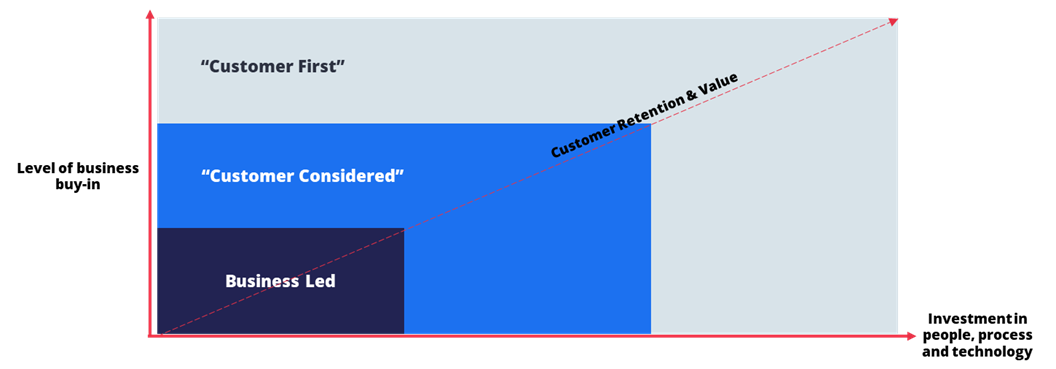Last week, some Plinc-ers attended a forum for senior retail and eCommerce professionals. Besides meeting all-star customer marketers and senior leaders in the retail sector, they gained some interesting insight into the topics on everyone’s minds.
We found it fascinating, and thought you might, too.
Here are our key takeaways from these conversations.
TL;DR: Customer marketers today are looking for ways to promote customer-centricity, increase retention and reward loyalty. There are many strategies to accomplish these goals, but they all require connected and operable customer data.
(Psst…we can help with that – get in touch to learn more.)
Customer-first strategies (and the impact they could have on KPIs)
This was, without a doubt, the discussion we heard most throughout the event. We know that consumer behaviour is trending toward promiscuity, and with the economy looking the way it is (grim), it’s never been more important to retain customers. It seems obvious, then, that marketers would want to develop customer-first approaches to business.
But what does that actually look like?
Many businesses will claim to be customer-first, but few truly are. To actually be customer-first, business success needs to be rooted in customer metrics rather than being sales led. That’s a big shift for most businesses, and it will require an upheaval of sales-driven measurement and KPIs.
Not only this, but customer-first businesses will have propositions and marketing activity driven by what the customer wants and expects rather than what the business wants to achieve. This may seem simple on its face, but it’s at odds with the way most businesses today operate. Not only does true customer-centricity require a philosophical shift within the business, but it also requires the tools to gather necessary customer information and the skills to derive insights from it. Business units will need to unite around this notion and will need common measures and practices to identify and act on these customer insights. Ultimately, this requires a shift in the people, process and (most likely) technology within the business.
With this in mind, we would argue that many businesses who claim to be customer-centric are actually merely “customer considerate”. They care about their customers and want to promote retention, but they are still business-led.

Fail fast and fix
Part of being a successful customer-first business, we discovered in our conversations, is the ability to “fail fast and fix”. This was a key takeaway from a fireside chat with the former CEO and co-owner of B&M, Simon Arora. B&M, Arora said, was a business built on agility. If something didn’t work, they would iterate, or in some cases, cut it entirely.
Failing fast and fixing seems to be a common thread within businesses that are truly customer-centric. To be customer-first, a business will need to reconcile customer metrics with traditional sales targets to identify opportunities and challenges and act on them. This requires reporting and insight built on a connected and dynamic customer data set.
More tactically, marketing test and learn needs to be established in a way that facilitates agility. These tests need strategic governance with defined guidelines. Put simply, to have the most impact on the business, test and learn needs clearly defined processes and cannot be carried out piece meal.
Loyalty
Loyalty seems to be the go-to strategy for retailers looking to create customer engagement and drive frequency. But it comes with a degree of wariness.
Establishing a loyalty program requires investment, both in terms of budget and time, and can become a burden to marketing teams – and even the brand – if not managed effectively. Traditional points-based loyalty schemes can be tricky to manage, and businesses need to ensure they manage exposure. With those considerations, are overt loyalty programs worth it?
Regardless of the structure of a loyalty program, the core intention should be the same: creating and rewarding positive customer behaviours. Of course, this is only possible with a 360-degree Single Customer View, which is comprised of connected and operable customer data in a single record.
Personalisation
Cross-channel personalisation and tailored customer journeys have long been lauded as gamechangers for customer marketing, yet our research shows that 43% still aren’t able to personalise effectively. Sure enough, personalisation remained high on the agenda for many of the businesses we spoke with at the event.
Of course, personalisation needs to be underpinned by effective technology. Data needs to be consolidated in real-time to inform intelligent personalised experiences, and it needs to be accessible across solutions and the broader business. But beyond this, businesses need people to manage it and process to ensure initiatives are holistic across channels and categories.
In-store experiences
There is a tendency to think about optimising customer experiences as being a digital/ecommerce initiative, but what about personalised customer experiences (CX) in-store?
Increasingly, hybrid CX is becoming more common, and therefore, businesses need to look beyond their digital channels to improve customer relationships. In retail and hospitality especially, customers’ expectations are heightening, and they want personalised interactions at every touchpoint, including in-store. Customer recognition is key to ensure this success, and this is again built on data foundations.
In order to optimise in-store CX, there needs to be a two-way flow of data: customer data needs to be available to in-store touchpoints and for staff, and the data captured in-store needs to flow back into the centralised database to be activated in the future.
The common thread
Reflecting on our conversations at this event, most of the attendees’ goals laddered back to a common theme: delivering meaningful, customer-centric experiences that bring value to the business.
To do this effectively, marketers (and the broader business) need accessible, unified and operable data. If your business is still struggling in this arena, get in touch to schedule a discovery call, where our solutions experts will learn more about your business to evaluate your data challenges and opportunities.
Blog posts

Lead the Brief: How CRM Becomes a Strategic Voice in Trading Decisions
CRM teams often arrive too late to shape strategy. Showing up with live insight repositions CRM as an contributor to commercial planning , not just the…

Connect the Journey: Building Real Omnichannel Intelligence
Disconnected journeys limit CRM’s impact. When CRM connects cross-channel behaviour into a clear customer view, it drives smarter personalisation,…

Be the Monday Hero: Escape the Reporting Scramble and Get Back to Strategy
Manual reporting keeps CRM teams reactive. Automating performance insight frees them to spot customer trends, guide strategy, and focus on the work that…

Fix the Loyalty Leak: Why Smarter CRM Reduces Margin Loss
Discounts may drive short-term sales, but smarter CRM targets loyalty behaviours that protect margin and build long-term value. Strategic incentives change…

See Beneath the Surface: Turning Segmentation into Strategic Intelligence
Segmentation isn’t just for targeting. When used to surface behavioural insight, it reveals where value is created, what predicts loyalty, and how CRM can…

Become a Customer Economist: Why CRM Should Speak in Value, Not Volume
CRM is often rich in insight but fails to speak the business’s language. Reframing performance in terms of customer value is key to influencing strategy…

